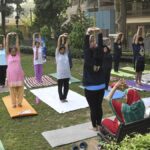
Twenty minutes of safe midday sun on forearms and face, brisk walking in a nearby park, climbing steps, or doing surya namaskar deliver Vitamin D and weight-bearing stimulus that tells bones to stay strong. File photograph used for representational purposes only
Strong bones rarely make headlines, yet without them the simplest daily acts would be impossible. That invisible strength is exactly what osteoporosis, whose name comes from the Greek for “porous bone,” quietly erodes. World Osteoporosis Day, marked on October 20 each year, is a prime time to put the spotlight on osteoporosis. Far more than a natural part of ageing, the condition develops when the lifelong balance between bone removal and bone formation tips towards excess loss, causing the skeleton to thin silently over years, while the person feels no different until the first break.

The numbers
The numbers reveal why Indian hospitals and health-policy planners are growing anxious. Current estimates place the prevalence of osteoporosis at roughly 50 million Indians, and with the country’s over-60 population projected to double by 2050, that figure is expected to triple. Around one in three women and one in five men above the age of 50 already sustain a fragility fracture in their remaining lifetime, and hip fractures dominate the toll: about one in four seniors who fracture a hip die within a year, while half lose the ability to walk without help or to live independently. The economic burden is equally sobering; a single hip-fixation surgery plus post-operative care can cost ₹2–3 lakh, and with more than 6,00,000 such fractures anticipated annually by 2030, the combined direct and indirect costs to families and the public exchequer could exceed ₹25,000 crore a year. Because most Indian women shoulder household caregiving duties, their fractures ripple through families and the informal economy, making osteoporosis as much a social issue as a medical one.

Myths and misconceptions
Public understanding in India, however, lags behind the science and is often shaped by long-held beliefs rather than facts. Many people still think osteoporosis strikes only “fair, thin, elderly women,” ignoring that men, younger women and every ethnic group across the subcontinent are increasingly affected. A second myth insists that daily cups of milk provide all the calcium one needs, yet Indian diets—especially vegetarian ones low in dairy—typically deliver less than 400 mg of calcium a day, far short of the 1,000 mg recommended after mid-life. Another misconception claims bone-density testing involves painful needles or huge expense; in truth, the quick, non-invasive DXA scan is available at most city hospitals for under ₹2,000 and is strongly advised for women at 65 and men at 70, earlier for anyone who has already suffered a fracture or uses steroid tablets for asthma, arthritis or tuberculosis

Prevention first
Prevention is far preferable to rescue, and it fits easily into an Indian way of life. A thali that includes two cups of low-fat curd or paneer, a handful of sesame or ragi (both naturally calcium-rich), a glass of fortified toned milk, and dark-green leafy vegetables can push daily calcium past the 1,000 mg mark; for those who are lactose-intolerant, calcium-fortified soy or almond drinks can help. Twenty minutes of safe midday sun on forearms and face, brisk walking in a nearby park, climbing steps, or doing surya namaskar deliver Vitamin D and weight-bearing stimulus that tells bones to stay strong. Traditional habits help too: pounding spices with a mortar and pestle, squatting while cutting vegetables, or sitting cross-legged on the floor keeps hips and the spine loaded in ways modern couches do not. Add 30 minutes of pranayama or yoga thrice a week to sharpen balance, cut fall risk, and strengthen core muscles, while cutting down tobacco and paan masala, and daily alcohol to a minimum. Parents who send children outdoors to play cricket or kho-kho and who replace colas with buttermilk set up the highest possible peak bone mass before adulthood, literally banking calcium for their child’s sixties.
Treatment options
When prevention is not enough, modern medicine offers proven options. After a fracture or a T-score of –2.5 or worse, doctors may prescribe oral or intravenous bisphosphonates that slow the bone-remodeling process, selective oestrogen receptor modulators for post-menopausal women, newer anabolic agents that rebuild bone, or in selected cases hormone-replacement therapy. Treatment plans now extend beyond tablets: fall-proofing the home, reviewing vision and medications that cause dizziness, and enrolling in physical-therapy programmes all reduce the chance of a first or repeat break: this is vital because up to half of patients who survive one fragility fracture will suffer another within five years.
World Osteoporosis Day urges each of us to “say no to fragile bones.” Whether you are 17 or 70, the actions you take today—choosing calcium-rich foods, climbing stairs instead of taking the lift, or asking your doctor about a baseline scan —translate into years of painless, independent living tomorrow. Strong bones are not an accident; they are a lifelong project that deserve the same attention we give hearts, lungs and skin. By replacing myths with knowledge and inertia with movement, we can ensure that the silent disease loses its voice before it breaks our stride.
(Dr. Backiaraj D. is a spine surgeon with the department of spine surgery and neurological sciences at Naruvi Hospitals, Vellore. backiaraj.d@naruvihospitals.com)
Published – October 20, 2025 07:30 am IST

